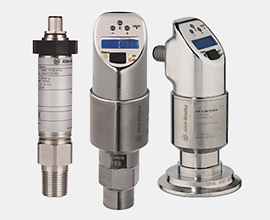Solid-State Condition Sensing Switches
Solid-State Condition Sensing Switches that are microprocessor based and designed with no moving parts, providing a longer service life and reducing downtime. In generic terms, solid-state sensors will have an interface, generally an oscillating circuit, the kind of which is the main distinction between the technologies. The inter face translates the distance into an electrical signal. A trigger, or threshold level detector, is used to trigger the output circuit when the signal reaches a predetermined level. An output circuit interfaces with data acquisition systems (PLCs, dedicated controllers), or other control circuits (relays, counters, timers, etc.).
Condition sensing switch like Solid-State Temperature Switches have features such as microprocessor based with no moving parts for longer life and reduced downtime, rugged, corrosion-resistant 316L stainless steel housing features an IP66 enclosure rating to withstand harsh industrial conditions, operating pressures from -15…6,000 psi (gauge), industry-leading four-digit 14-segment digital display, independently programmable dual PNP N.O./N.C. outputs or 4…20 mA analog output and stainless steel sensing element.
Modern Technology
Magnet Operated (reed relay)
Advantage: Inexpensive; very selective target identification. Disadvantages: Magnet required. Sensitive to welding fields. Applications: Security and safety interlocking. Sensing through metal.
Hall Effect
Advantage: Complete switching function is in a single integrated circuit. Operates up to 150 kHz. High temperature (150°C). Good resolution. Disadvantages: Magnetic target only. Extremely sensitive to industrial environment. Applications: Keyboard.
Ultrasonic
Advantage: Senses all materials. Disadvantages: Resolution. Repeatability; sensitive to background and environment changes. Applications: Anti-collision on AGV (Automated Guided Vehicles). Doors.
Inductive
Advantage: Resistant to harsh environments. Easy to install; very predictable. Disadvantages: Distance to limitation to 60mm. Applications: Presence detection on all kinds of machines and installations.
Photoelectric
Advantage: Senses all materials. Longest sensing range. Versatile. Disadvantages: Subject to contamination. Applications: Parts detection. Material handling. Packaging.
The sensor output of solid-state (electronic), as the name implies, solid-state switches have no moving parts. Power is required by the solid-state switch at all times. These switches need a certain amount of current to energize the circuitry and the output, and there is voltage across the switch even when the circuit is closed. When it’s open, there is a certain amount of current (leakage current) pass through it. Examples of solid-state switches include transistors, TRIACs, and SCRs.
Advantages
- There are some important advantages to solid-state switches, such as:
- Wear is not a factor, because there are no moving parts.
- The switches operate extremely fast, because inertia is not a factor.
- AC switches do not generate noise and transients as a result of arcing. They stop conducting when current reaches zero. Therefore, there is no energy left to generate arcing.
- The devices work extremely well at low energy-especially DC switches.
Disadvantages
- The disadvantages of solid-state switches include:
- Solid-state switches must be powered at all times. When they are open, leakage current flows through the load. When they are closed, there is a voltage drop to power the switch which must be considered. Leakage current can be microamps or milliamps in magnitude. Depending on the technology and the amount of current conducted, voltage drop can be millivolts up to several volts.
- Transients in the power supply can send false signals to the switch, or even cause it to fail completely. Clean power is essential.
- Solid-state switches, while well-suited for low-energy applications, have difficulty with high-current applications. Because of the voltage drop, these switches generate heat. At current level above 0.5A, these sensors need bulky heat sinks to dissipate the heat.
